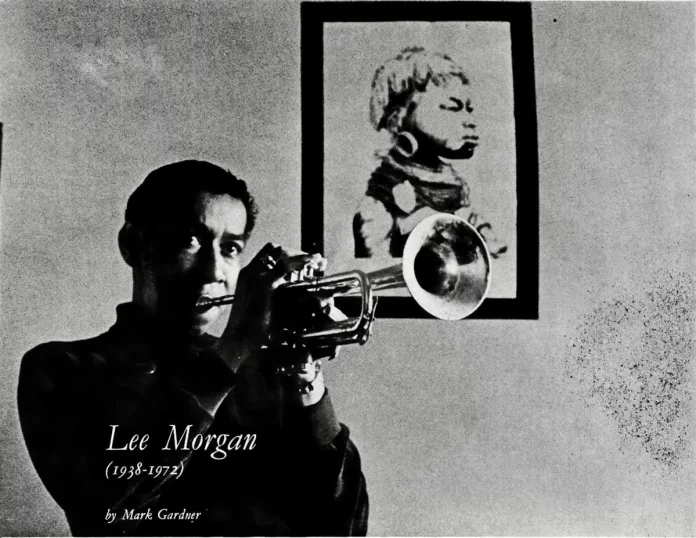Lee Morgan, one of the brighter trumpet lights of the 1950s, became yet another victim of the violent times in which we live when he was murdered during an engagement at Slug’s, a New York jazz club, on February 19. Morgan is reported to have been shot and his killing recalls the slaying of Al Killian, also a trumpeter, in 1950. Lee Morgan was 33 years old.
This fine musician first blazed into prominence with Dizzy Gillespie’s Big Band in 1956. Clearly, Dizzy thought highly of him because he featured the younger man prominently, and his work on That’s All from a 1957 date shows that at 19, Lee was already a formidable soloist.
Born in Philadelphia on July 10, 1938, Morgan studied trumpet privately and at Mastbaum Tech. At school he doubled on alto horn and by the age of 15 was already gigging around the city with bassist Spanky DeBrest and others. Morgan’s earliest and most lasting influence, one might almost say exclusive influence, was Clifford Brown. As a young boy he heard Brown many times and indeed sat in with him frequently. Lee also expressed admiration for Gillespie, Fats Navarro, Kenny Dorham, Thad Jones and Art Farmer.
While with the Gillespie band, Morgan settled in New York and soon signed a contract with Blue Note Records. His first album for the label, ‘Presenting Lee Morgan’ (BLP 1538), was cut on November 4, 1956, with a quintet including Clarence Sharpe (alto), Horace Silver (piano), Wilbur Ware (bass) and Philly Joe Jones (drums). It boasted some scintillating solos by the young hornman and served to widen his growing reputation.
Subsequently Morgan was heard on record with all the hard boppers and he found his natural musical home when he joined Art Blakey’s Jazz Messengers in 1958. He had played with Blakey two years earlier but now he was really ready for such a group. This first association with the drummer lasted until 1961 but was often resumed during the 1960s.
After his first Blue Note contract expired, Morgan went on to record for Roulette, Veejay, but then he re-signed with Blue Note again and made some of his best albums for that label in the late 1960s. Lee has also recorded for Savoy in earlier years. His greatest commercial success was ‘The Sidewinder’ album which made the Billboard charts in 1963 but it was by no means his most creative recorded work. For that one must turn to his sides with Art Blakey, especially a 1961 set on Impulse, and such Blue Note collections under his own name as ‘Candy’ (a remarkable quartet date with Sonny Clark) and ‘The Sixth Sense’, a fine latter-day effort.
Both his Vee-Jay albums ‘Expoobident’ and ‘Here’s Lee Morgan’ are outstanding and on each he is partnered by the excellent Clifford Jordan (tenor). These two, with a different rhythm section, also teamed up to make ‘Take Twelve’, a rewarding Jazzland session which includes four of the trumpeter’s attractive original tunes. Another two LPs featuring Morgan which should be in everybody’s collection are John Coltrane’s ‘Blue Train’ and Johnny Griffin’s ‘A Blowing Session’, both on Blue Note.
Morgan’s life was not without personal troubles. For years he wrestled with narcotics problems but had apparently overcome these difficulties, which had interrupted his career at various times, in recent years. His recordings were sometimes uneven, probably because of his physical hang-ups, and he would then fall back on repetitive ‘soul’ cliches. But when he was well, few of his contemporaries could match his technical brilliance and invention.
Recently he had been actively involved in such enterprises as College Black Artists, the Jazz and People Movement and the Harlem Jazzmobile. He was one of the men who led protests on New York television studios about their refusal to give exposure to black musicians. He had become a militant.
Lee Morgan was a good musician rather than a great one. He was not an original stylist but he made a significant contribution to jazz over a 15-year-period. His mercurial trumpet will be missed, particularly by those who came to jazz during the hard bop era when Morgan was a young man with a funky horn.
















